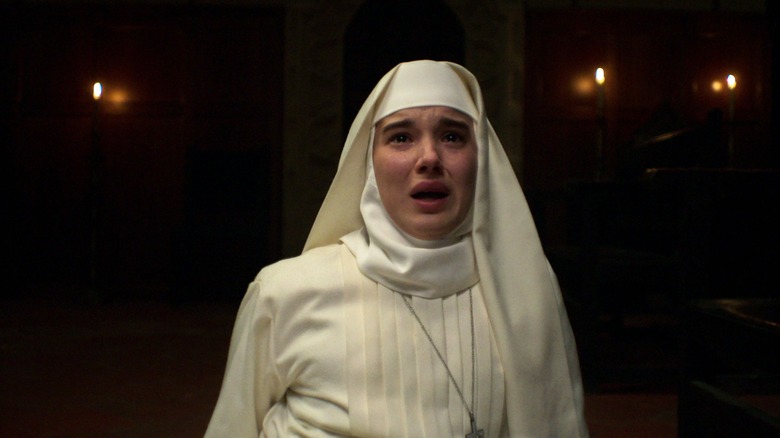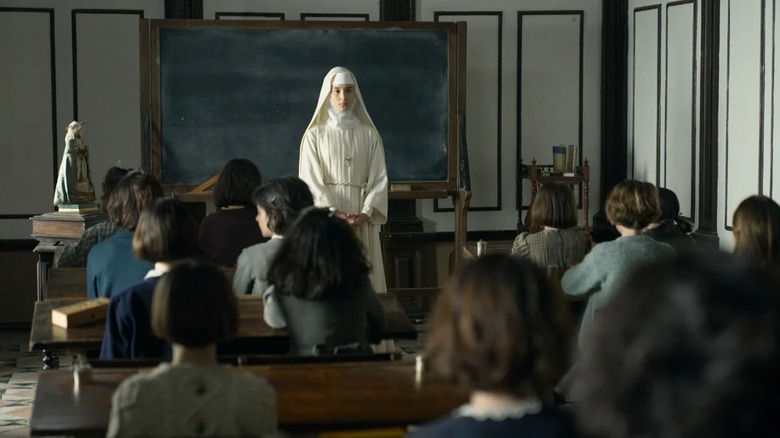Spanish Horror Film Sister Death Is Serving Up Big Scares In Netflix's Top 10
Creepy convents, possessed nuns, and supernatural visions: These horror tropes always manage to evoke scares, provided that they are supported by a gripping, unnerving story. When Spanish-language horror "Verónica" was released in 2017, it was hailed as a deeply frightening experience, one that portrayed the harrowing possession of a young student in heartbreaking, visceral detail. Now, the prequel to "Verónica," titled "Sister Death," has made it to Netflix's Top 10 worldwide, offering more context to its predecessor by telling a brand new story about a nun contending with the lofty expectations of her convent, while struggling with visions that might or might not be spine-chilling hallucinations.
Director Paco Plaza returned to direct the sequel, which is much more than your standard possession flick — it is an origin story that enriches our understanding of the tribulations Verónica underwent, deepening themes established by the original. This does not mean "Sister Death" cannot be enjoyed as a standalone journey, as the film does not lean too much into its existing lore, despite forging meaningful connections with it. The presence of Sister Narcisa (Aria Bedmar) is engaging enough to keep fresh audiences hooked, and while it is not necessary to connect her to the same blind nun that Verónica and her friends knew, the connection does enrich our understanding of how Narcisa became the person she is today.
Set during the Spanish Civil War, "Sister Death" carries a heavy, oppressive air that changes quality with the nature of the scares throughout the course of its slow-burn mystery. As the stakes are amped up, things suddenly become jarring, where locales that once seemed beautiful take on a terrifying, haunting tinge. Here's what you can expect from "Sister Death" and the labyrinths of fear it weaves for us to navigate.
A terrifying origin story
The film opens with Narcisa, who is believed to be a religious prodigy after she claimed to have seen the Virgin Mary in a vision as a child, which quickly elevates her to "celebrity" status among the nuns at the convent. Left to contend with the lofty expectations of those around her, Narcisa feels quite torn about pursuing nun-hood, as she is not sure about committing to this way of life without considering all facets of her inclinations. Faith is like a chameleon that changes color as it constantly takes on new meanings with personal revelations, and is often used as a means to chain individuals to dogma. Narcisa acutely experiences these shifts, especially when one of her students experiences possession, which leads the nun on a path of no return.
The symbolism employed in "Verónica" returns to underline the central idea of dark entities being summoned during an eclipse, which ties into the convent's dark history, which remains ever-elusive. More questions pile up as Narcisa finds herself faced with an impossible situation, and she's tempted to flirt with the occult in her search for more answers. Plaza paces the first half like a slow-burn mystery thriller, and just when we are comfortable enough to expect more of the same, the scares are employed in increasingly unsettling ways. There's ample room for ambiguity too, as "Sister Death" does not offer too much clarity, preferring to reveal just enough to make audiences think deeper and establish links that might or might not end up feeding into its core essence.
A double feature with "Verónica" would be a perfect way to experience "Sister Death," as both films treat an overlapping tale differently, but complement one another in near-perfect ways.
"Sister Death" is currently streaming on Netflix.

